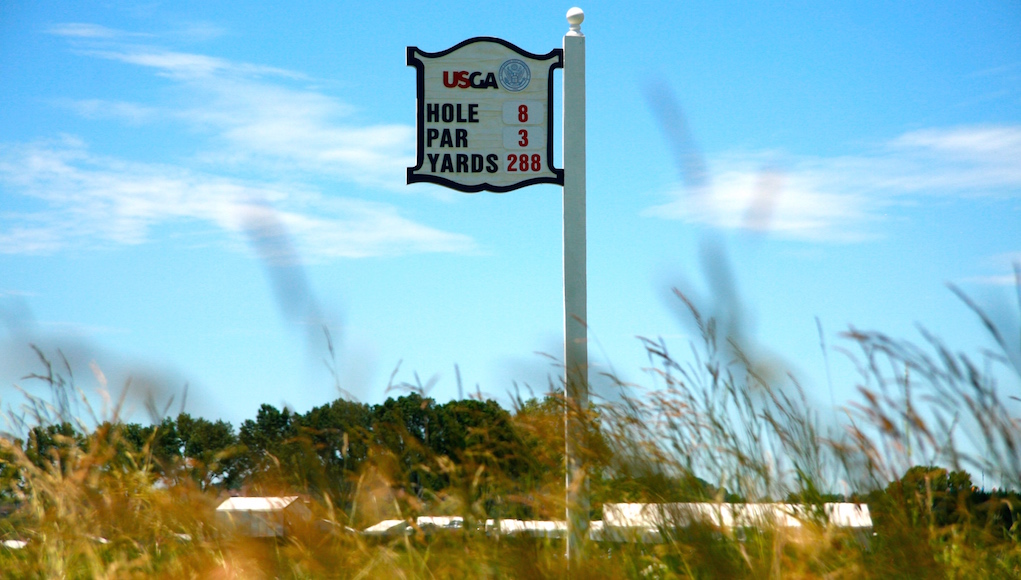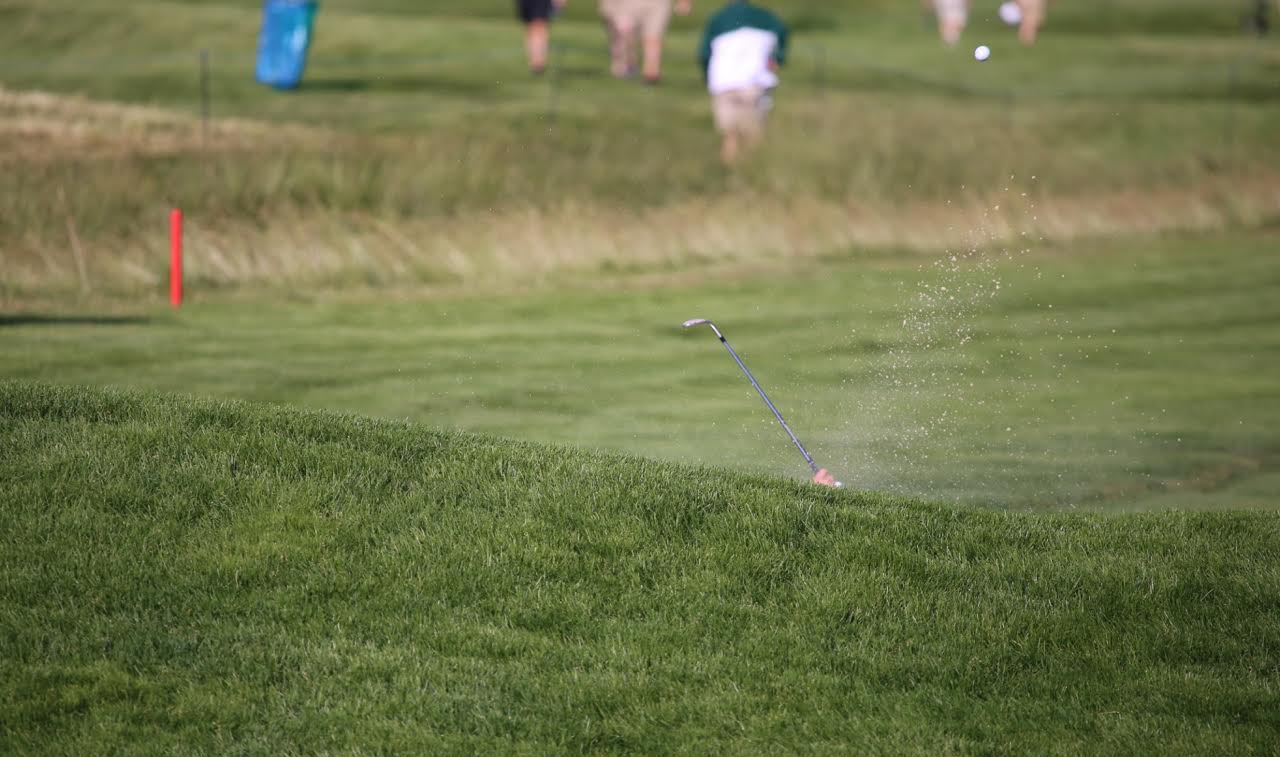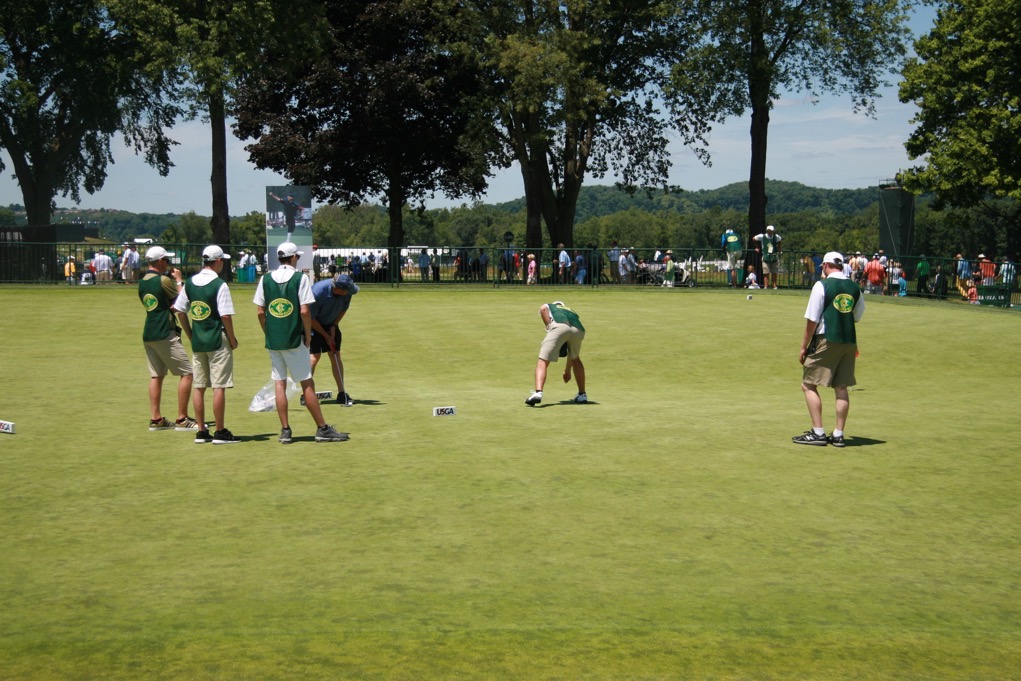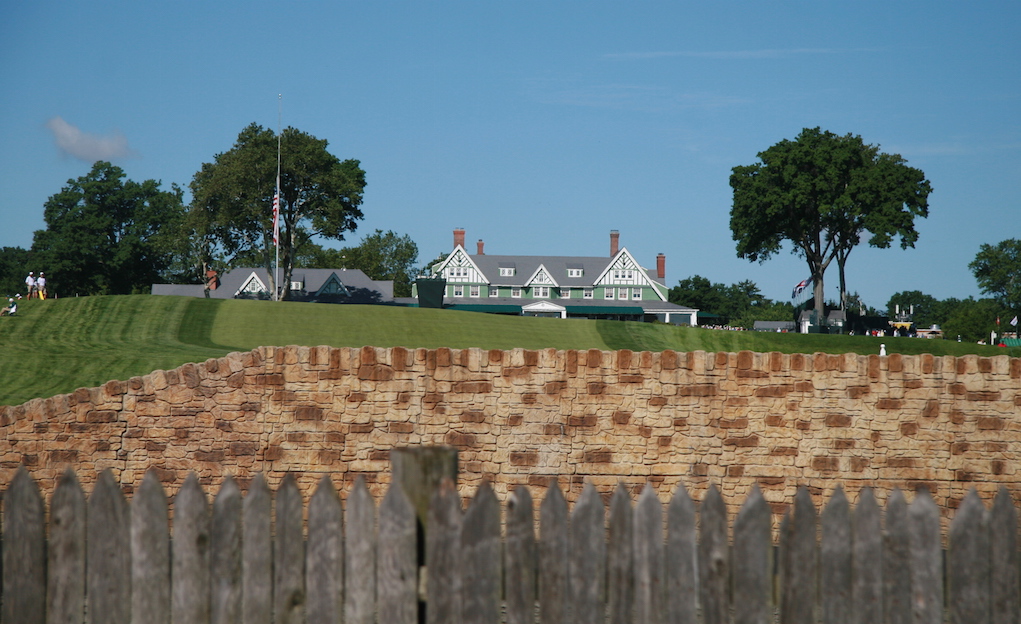Opinion & Analysis
What’s so difficult about Oakmont, anyway?

It’s a golf tradition unlike any other; players complaining about the U.S. Open setup ahead of the event. The course is either too long, too dried out, the rough too long, the greens too fast, or some combination of all those factors. And golf fans relish in hearing the complaints. It’s one of the few times each year when the best players in the world make fools of themselves when competing against par.
There’s something different about how players talk about this year’s U.S. Open at Oakmont Country Club, though. When they talk about the setup, or how how difficult the course is, there’s legitimate fear in their eyes. Every year the media, course members and players predict an over-par winning score, but at Oakmont you can sense that everyone is serious about it.
What makes Oakmont so difficult? I traveled there to find out, and asked the fans what they believe makes the course so treacherous.
What bunkers?
“The biggest problem is that you can’t even see some of these bunkers they’re so deep,” one fan said.
While U.S. Open contestants will know where all the bunkers are located, they won’t be able to see many of them from the tee or from the fairway. And the bunkers they can’t see are some of the deepest, most penalizing bunkers on the course.
“I’d be stuck in some of these bunkers and would never get out,” a fan said.
- Church Pews, hole No. 3
- The mounds in the Church Pew bunker are taller than they appear on video.
- Church Pew bunker, hole No. 15
- A bunker guarding the green at hole No.6, with a lip nearly taller than this player.
And when you do see the bunkers, like the Church Pews on the left of Nos. 3 and 4, or the Church Pews on the left of No. 15 — actually most, of the 200-plus bunkers on the course — you wish you hadn’t.
The green complexes are… complex
On No. 2 green, I watched players, caddies, coaches and whoever else was in the practice-round entourage gather at the center of that green, rolling and dropping golf balls to see how they would react. On multiple occasions, I watched someone drop a golf ball in the center of the green only to watch it slowly funnel off of the green down into the fairway.
“One second you’re putting, and then all the sudden you’re chipping,” one fan told me. “For me, I’d be putting, putting and then chipping,” his friend responded.
The green complexes are firm, diabolical, and just purely fast. They’re rumored to be running at a 14 on the Stimpmeter. That’s unheard of for any golf course that isn’t named Augusta, which doesn’t release its green speeds.
To give fans an experience of the greens at Oakmont, the USGA set up an exact replica of the 18th green for fans to test out their strokes. Oakmont caddies were stationed at the greens to help out.
“It’s like putting on a sloped basketball court,” one fan told me.
Maybe Rory McIlroy wasn’t kidding when he said he’d rather have a 30-footer uphill than an 8-footer downhill.
Where art thou iron byron?
“I could bring a portable Iron Byron out here and not hit every fairway,” a fan told me.
Oakmont is long, a par-70 that will play around 7,200 yards depending on the tees, but it’s not THAT long compared to some of the other U.S. Open venues, or even regular Tour stops. It’s how tight some of the landing areas are that makes it play longer. It’s a must that players keep their ball in the fairway due to long rough and deep bunkers. That’s why you’ll hear many of them saying they’ll only use driver off the tee 4-8 times each round, opting for more control with long irons, fairway woods woods and hybrids off the tees.
“It’s one of those courses where if you drink a few too many beers, you could be walking in the fairway, stumble just a little, and end up in the rough. The fairways are just stupid tight,” said one fan.
He may have already had a few beers that day, as well.
The blind leading the blind
“I didn’t realize how much elevation change was at this place,” a fan said. “You can hardly see anything on some holes.”
Like the bunkers, it’s difficult to see many of the landing areas from the tees at Oakmont, especially on Nos. 1, 5, 9, 15 and 17. That means players must put their ultimate trust in their preparation and the target lines they’ve established prior to the event.
The Hardest Hole
I got a different answer to the question “What do you think is the hardest hole out here?” from nearly everyone I asked, but the most common answers were holes 1, 2, 7, 8 and 18.
No. 1 (Par 4, 482 yards)
Why not? A 118-yard putt on the first hole at #Oakmont. pic.twitter.com/GRU0E29Zvu
— Guy Cipriano (@GCIMagazineGuy) April 25, 2016
This video says it all.
No. 2 (Par 4, 340 yards)
See above: One second you’re rolling balls onto the green, the next, you’re following the balls as they roll off the green.
No. 7 (Par 4, 479 yards)
“That hole seems too unfair from all the way back where they need to play from,” said a fan, shaking his head.
I’m sure some of the players agree, especially when you consider how the green slopes hard from left-to-right.
No. 8 (Par 3, 288/250 yards)
“I’d probably hit driver-6 iron here, and then have a short chip on.”
This 288-yard par 3, or 250 yards, depending what tee box the USGA uses that round, is cause of terror for most fans who collect on that tee box. But the truth is, most of the players hit hybrids and long irons. Angel Cabrera hit a 6-iron (gasp) during Monday’s practice round.
“The ball gets a nice ground hook once it lands in front of the green, so you only have to carry it about 250,” one caddie said.
A 250-yard 6-iron is still a big hit, regardless.
No. 18 (Par 4, 484 yards)
It may be the most difficult finishing hole in golf. In 2007, only 43 percent of the players hit the green in regulation, and it was statistically the most difficult hole on the course in relation to par.
“I’m not sure whether the hole itself is that hard, or it’s just because you’ve been beaten to shreds on the previous 17,” a fan hypothesized.
Probably a bit of both.
The rough is longer than…
There’s been plenty of talk, visuals and Twitter videos from players and media about how long the rough is at Oakmont. But none more hilarious than this interaction between a couple in their mid-twenties.
“This rough is longer than my…” said the man.
“Yea, a lot longer,” says the woman.
Ouch.
So what makes Oakmont so difficult? It’s the combination of not just one thing, or a few of these things, but ALL of these factors. Oakmont might very well be the most difficult test of golf in the U.S., and we may very well see a winning score in the black.
When asked if he would cherish the opportunity to play a course like this, a 4-handicap golfer answered “Ain’t nothin’ fun about not breaking 90.” We may just see a U.S. Open participant fail to break 90 this week, as well.
Thanks to all of the fans who put up with my questions during the practice rounds!
- LIKE82
- LEGIT8
- WOW4
- LOL2
- IDHT0
- FLOP0
- OB0
- SHANK8
19th Hole
Vincenzi’s LIV Golf Singapore betting preview: Course specialist ready to thrive once again

After another strong showing in Australia, LIV Golf will head to Sentosa Golf Club in Singapore looking to build off of what was undoubtedly their best event to date.
Sentosa Golf Club sits on the southern tip of Singapore and is one of the most beautiful courses in the world. The course is more than just incredible scenically; it was also rated 55th in Golf Digest’s top-100 courses in 2022-2023 and has been consistently regarded as one of the best courses in Asia. Prior to being part of the LIV rotation, the course hosted the Singapore Open every year since 2005.
Sentosa Golf Club is a par 71 measuring 7,406 yards. The course will require precise ball striking and some length off the tee. It’s possible to go low due to the pristine conditions, but there are also plenty of hazards and difficult spots on the course that can bring double bogey into play in a hurry. The Bermudagrass greens are perfectly manicured, and the course has spent millions on the sub-air system to keep the greens rolling fast. I spoke to Asian Tour player, Travis Smyth, who described the greens as “the best [he’s] ever played.”
Davis Love III, who competed in a Singapore Open in 2019, also gushed over the condition of the golf course.
“I love the greens. They are fabulous,” the 21-time PGA Tour winner said.
Love III also spoke about other aspects of the golf course.
“The greens are great; the fairways are perfect. It is a wonderful course, and it’s tricky off the tee.”
“It’s a long golf course, and you get some long iron shots. It takes somebody hitting it great to hit every green even though they are big.”
As Love III said, the course can be difficult off the tee due to the length of the course and the trouble looming around every corner. It will take a terrific ball striking week to win at Sentosa Golf Club.
In his pre-tournament press conference last season, Phil Mickelson echoed many of the same sentiments.
“To play Sentosa effectively, you’re going to have a lot of shots from 160 to 210, a lot of full 6-, 7-, 8-iron shots, and you need to hit those really well and you need to drive the ball well.”
Golfers who excel from tee to green and can dial in their longer irons will have a massive advantage this week.
Stat Leaders at LIV Golf Adelaide:
Fairways Hit
1.) Louis Oosthuizen
2.) Anirban Lahiri
3.) Jon Rahm
4.) Brendan Steele
5.) Cameron Tringale
Greens in Regulation
1.) Brooks Koepka
2.) Brendan Steele
3.) Dean Burmester
4.) Cameron Tringale
5.) Anirban Lahiri
Birdies Made
1.) Brendan Steele
2.) Dean Burmester
3.) Thomas Pieters
4.) Patrick Reed
5.) Carlos Ortiz
LIV Golf Individual Standings:
1.) Joaquin Niemann
2.) Jon Rahm
3.) Dean Burmester
4.) Louis Oosthuizen
5.) Abraham Ancer
LIV Golf Team Standings:
1.) Crushers
2.) Legion XIII
3.) Torque
4.) Stinger GC
5.) Ripper GC
LIV Golf Singapore Picks
Sergio Garcia +3000 (DraftKings)
Sergio Garcia is no stranger to Sentosa Golf Club. The Spaniard won the Singapore Open in 2018 by five strokes and lost in a playoff at LIV Singapore last year to scorching hot Talor Gooch. Looking at the course setup, it’s no surprise that a player like Sergio has played incredible golf here. He’s long off the tee and is one of the better long iron players in the world when he’s in form. Garcia is also statistically a much better putter on Bermudagrass than he is on other putting surfaces. He’s putt extremely well on Sentosa’s incredibly pure green complexes.
This season, Garcia has two runner-up finishes, both of them being playoff losses. Both El Camaleon and Doral are courses he’s had success at in his career. The Spaniard is a player who plays well at his tracks, and Sentosa is one of them. I believe Sergio will get himself in the mix this week. Hopefully the third time is a charm in Singapore.
Paul Casey +3300 (FanDuel)
Paul Casey is in the midst of one of his best seasons in the five years or so. The results recently have been up and down, but he’s shown that when he’s on a golf course that suits his game, he’s amongst the contenders.
This season, Casey has finishes of T5 (LIV Las Vegas), T2 (LIV Hong Kong), and a 6th at the Singapore Classic on the DP World Tour. At his best, the Englishman is one of the best long iron players in the world, which makes him a strong fit for Sentosa. Despite being in poor form last season, he was able to fire a Sunday 63, which shows he can low here at the course.
It’s been three years since Casey has won a tournament (Omega Dubai Desert Classic in 2021), but he’s been one of the top players on LIV this season and I think he can get it done at some point this season.
Mito Pereira +5000 (Bet365)
Since Mito Pereira’s unfortunate demise at the 2022 PGA Championship, he’s been extremely inconsistent. However, over the past few months, the Chilean has played well on the International Series as well as his most recent LIV start. Mito finished 8th at LIV Adelaide, which was his best LIV finish this season.
Last year, Pereira finished 5th at LIV Singapore, shooting fantastic rounds of 67-66-66. It makes sense why Mito would like Sentosa, as preeminent ball strikers tend to rise to the challenge of the golf course. He’s a great long iron player who is long and straight off the tee.
Mito has some experience playing in Asia and is one of the most talented players on LIV who’s yet to get in the winner’s circle. I have questions about whether or not he can come through once in contention, but if he gets there, I’m happy to roll the dice.
Andy Ogletree +15000 (DraftKings)
Andy Ogletree is a player I expected to have a strong 2024 but struggled early in his first full season on LIV. After failing to crack the top-25 in any LIV event this year, the former U.S. Amateur champion finally figured things out, finished in a tie for 3rd at LIV Adelaide.
Ogletree should be incredible comfortable playing in Singapore. He won the International Series Qatar last year and finished T3 at the International Series Singapore. The 26-year-old was arguably the best player on the Asian Tour in 2023 and has been fantastic in the continent over the past 18 months.
If Ogletree has indeed found form, he looks to be an amazing value at triple-digit odds.
- LIKE3
- LEGIT3
- WOW1
- LOL2
- IDHT0
- FLOP2
- OB0
- SHANK0
Opinion & Analysis
Ryan: Lessons from the worst golf instructor in America

In Tampa, there is a golf course that boasts carts that do not work, a water range, and a group of players none of which have any chance to break 80. The course is overseen by a staff of crusty men who have succeeded at nothing in life but ending up at the worst-run course in America. However, this place is no failure. With several other local courses going out of business — and boasting outstanding greens — the place is booked full.
While I came for the great greens, I stayed to watch our resident instructor; a poor-tempered, method teacher who caters to the hopeless. At first, it was simply hilarious. However, after months of listening and watching, something clicked. I realized I had a front-row seat to the worst golf instructor in America.
Here are some of my key takeaways.
Method Teacher
It is widely accepted that there are three types of golf instructors: system teachers, non-system teachers, and method teachers. Method teachers prescribe the same antidote for each student based on a preamble which teachers can learn in a couple day certification.
Method teaching allows anyone to be certified. This process caters to the lowest caliber instructor, creating the illusion of competency. This empowers these underqualified instructors with the moniker of “certified” to prey on the innocent and uninformed.
The Cult of Stack and Jilt
The Stack and Tilt website proudly boasts, “A golfer swings his hands inward in the backswing as opposed to straight back to 1) create power, similar to a field goal kicker moving his leg in an arc and 2) to promote a swing that is in-to-out, which produces a draw (and eliminates a slice).”
Now, let me tell you something, there is this law of the universe which says “energy can either be created or destroyed,” so either these guys are defying physics or they have no idea what they are taking about. Further, the idea that the first move of the backswing determines impact is conjecture with a splash of utter fantasy.
These are the pontifications of a method — a set of prescriptions applied to everyone with the hope of some success through the placebo effect. It is one thing for a naive student to believe, for a golf instructor to drink and then dispel this Kool-Aid is malpractice.
Fooled by Randomness
In flipping a coin, or even a March Madness bet, there is a 50-50 chance of success. In golf, especially for new players, results are asymmetric. Simply put: Anything can happen. The problem is that when bad instructors work with high handicappers, each and every shot gets its own diagnosis and prescription. Soon the student is overwhelmed.
Now here’s the sinister thing: The overwhelming information is by design. In this case, the coach is not trying to make you better, they are trying to make you reliant on them for information. A quasi Stockholm syndrome of codependency.
Practice
One of the most important scientists of the 20th century was Ivan Pavlov. As you might recall, he found that animals, including humans, could be conditioned into biological responses. In golf, the idea of practice has made millions of hackers salivate that they are one lesson or practice session from “the secret.”
Sunk Cost
The idea for the worst golf instructor is to create control and dependency so that clients ignore the sunk cost of not getting better. Instead, they are held hostage by the idea that they are one lesson or tip away from unlocking their potential.
Cliches
Cliches have the effect of terminating thoughts. However, they are the weapon of choice for this instructor. Add some hyperbole and students actually get no information. As a result, these players couldn’t play golf. When they did, they had no real scheme. With no idea what they are doing, they would descend into a spiral of no idea what to do, bad results, lower confidence, and running back to the lesson tee from more cliches.
The fact is that poor instruction is about conditioning players to become reliant members of your cult. To take away autonomy. To use practice as a form of control. To sell more golf lessons not by making people better but through the guise that without the teacher, the student can never reach their full potential. All under the umbrella of being “certified” (in a 2-day course!) and a melee of cliches.
This of course is not just happening at my muni but is a systemic problem around the country and around the world, the consequences of which are giving people a great reason to stop playing golf. But hey, at least it’s selling a lot of golf balls…
- LIKE17
- LEGIT1
- WOW0
- LOL4
- IDHT1
- FLOP0
- OB0
- SHANK17
19th Hole
Vincenzi’s 2024 Zurich Classic of New Orleans betting preview

The PGA TOUR heads to New Orleans to play the 2023 Zurich Classic of New Orleans. In a welcome change from the usual stroke play, the Zurich Classic is a team event. On Thursday and Saturday, the teams play best ball, and on Friday and Sunday the teams play alternate shot.
TPC Louisiana is a par 72 that measures 7,425 yards. The course features some short par 4s and plenty of water and bunkers, which makes for a lot of exciting risk/reward scenarios for competitors. Pete Dye designed the course in 2004 specifically for the Zurich Classic, although the event didn’t make its debut until 2007 because of Hurricane Katrina.
Coming off of the Masters and a signature event in consecutive weeks, the field this week is a step down, and understandably so. Many of the world’s top players will be using this time to rest after a busy stretch.
However, there are some interesting teams this season with some stars making surprise appearances in the team event. Some notable teams include Patrick Cantlay and Xander Schauffele, Rory McIlroy and Shane Lowry, Collin Morikawa and Kurt Kitayama, Will Zalatoris and Sahith Theegala as well as a few Canadian teams, Nick Taylor and Adam Hadwin and Taylor Pendrith and Corey Conners.
Past Winners at TPC Louisiana
- 2023: Riley/Hardy (-30)
- 2022: Cantlay/Schauffele (-29)
- 2021: Leishman/Smith (-20)
- 2019: Palmer/Rahm (-26)
- 2018: Horschel/Piercy (-22)
- 2017: Blixt/Smith (-27)
2024 Zurich Classic of New Orleans Picks
Tom Hoge/Maverick McNealy +2500 (DraftKings)
Tom Hoge is coming off of a solid T18 finish at the RBC Heritage and finished T13 at last year’s Zurich Classic alongside Harris English.
This season, Hoge is having one of his best years on Tour in terms of Strokes Gained: Approach. In his last 24 rounds, the only player to top him on the category is Scottie Scheffler. Hoge has been solid on Pete Dye designs, ranking 28th in the field over his past 36 rounds.
McNealy is also having a solid season. He’s finished T6 at the Waste Management Phoenix Open and T9 at the PLAYERS Championship. He recently started working with world renowned swing coach, Butch Harmon, and its seemingly paid dividends in 2024.
Keith Mitchell/Joel Dahmen +4000 (DraftKings)
Keith Mitchell is having a fantastic season, finishing in the top-20 of five of his past seven starts on Tour. Most recently, Mitchell finished T14 at the Valero Texas Open and gained a whopping 6.0 strokes off the tee. He finished 6th at last year’s Zurich Classic.
Joel Dahmen is having a resurgent year and has been dialed in with his irons. He also has a T11 finish at the PLAYERS Championship at TPC Sawgrass which is another Pete Dye track. With Mitchell’s length and Dahmen’s ability to put it close with his short irons, the Mitchell/Dahmen combination will be dangerous this week.
Taylor Moore/Matt NeSmith +6500 (DraftKings)
Taylor Moore has quickly developed into one of the more consistent players on Tour. He’s finished in the top-20 in three of his past four starts, including a very impressive showing at The Masters, finishing T20. He’s also finished T4 at this event in consecutive seasons alongside Matt NeSmith.
NeSmith isn’t having a great 2024, but has seemed to elevate his game in this format. He finished T26 at Pete Dye’s TPC Sawgrass, which gives the 30-year-old something to build off of. NeSmith is also a great putter on Bermudagrass, which could help elevate Moore’s ball striking prowess.
- LIKE8
- LEGIT3
- WOW1
- LOL1
- IDHT0
- FLOP3
- OB1
- SHANK2
-

 19th Hole1 week ago
19th Hole1 week agoJustin Thomas on the equipment choice of Scottie Scheffler that he thinks is ‘weird’
-

 19th Hole1 week ago
19th Hole1 week ago‘Absolutely crazy’ – Major champ lays into Patrick Cantlay over his decision on final hole of RBC Heritage
-

 19th Hole3 weeks ago
19th Hole3 weeks agoTwo star names reportedly blanked Jon Rahm all week at the Masters
-

 19th Hole2 weeks ago
19th Hole2 weeks agoReport: LIV Golf identifies latest star name they hope to sign to breakaway tour
-

 19th Hole2 weeks ago
19th Hole2 weeks agoNeal Shipley presser ends in awkward fashion after reporter claims Tiger handed him note on 8th fairway
-

 19th Hole2 weeks ago
19th Hole2 weeks agoBrandel Chamblee has ‘no doubt’ who started the McIlroy/LIV rumor and why
-

 Equipment3 weeks ago
Equipment3 weeks agoWhat we know about Bryson DeChambeau’s 3D-printed Avoda irons
-

 19th Hole6 days ago
19th Hole6 days agoLET pro gives detailed financial breakdown of first week on tour…and the net result may shock you




































Dave
Jun 19, 2016 at 10:34 pm
love the comments . But like logical said its getting old
PuffyC
Jun 19, 2016 at 3:50 pm
At some point you cross from difficult to silly, where dumb luck starts to play a factor in who wins and loses. I’d rather see a course that rewards true skill, not luck on blind tee shots, bad kicks into knee length rough, or a ball that happens to stick on the green instead of rolling back into the fairway. It’s not fun to watch and I assume not fun to play.
Tom
Jun 19, 2016 at 9:07 am
Although its turf conditions are second to none (no doubt about that), the course barely squeaks into the top 5 in Western PA alone.That “return the golf course to its original splendor” line that the USGA uses is total crap. Oakmont’s logo is a squirrel!!!!!!!! I love the US Open but the USGA has become the emperor with no clothes. Yesterday, I heard an announcer describing all the blind shots at Oakmont like it was a good thing. And it wasn’t even Jim Nance.
Hole11
Jun 17, 2016 at 9:21 am
How about fairways 10 yards wide and 12 inch rough. Oh boy would that be tough. No…it would just be stupid. Or greens so fast and sloped no ball would stay on so you’d have to chip it in to finish the hole. Bunkers so deep only an unplayable lay could get you out. Approaching silliness is not impressive, it’s just plain dumb.
.
Other Paul
Jun 16, 2016 at 9:12 pm
i would want to play twice. Once to get adjusted, a night to relax and then another try at it. I have some length, and that makes me brave. Or sometimes stupid…
michael johnson
Jun 16, 2016 at 6:04 pm
i shot an easy 62 the other day at oakmont, so yeah, its really not that difficult.
ooffa
Jun 16, 2016 at 2:01 pm
They all play the same course. Low score wins. Whoever is putting the best this week will win just like every other week on tour. Easy or hard makes no difference. It’s just just another week and another golf course to the pros.
Logical
Jun 16, 2016 at 1:31 pm
This is a silly article. There’s no difference in how they are talking about the course this year, there’s no “fear in their eyes”. There have been many tough setups at US Opens, this isn’t any more or less “special”.
Come on, stop trying to hype the heck out of the course. It’s getting old.